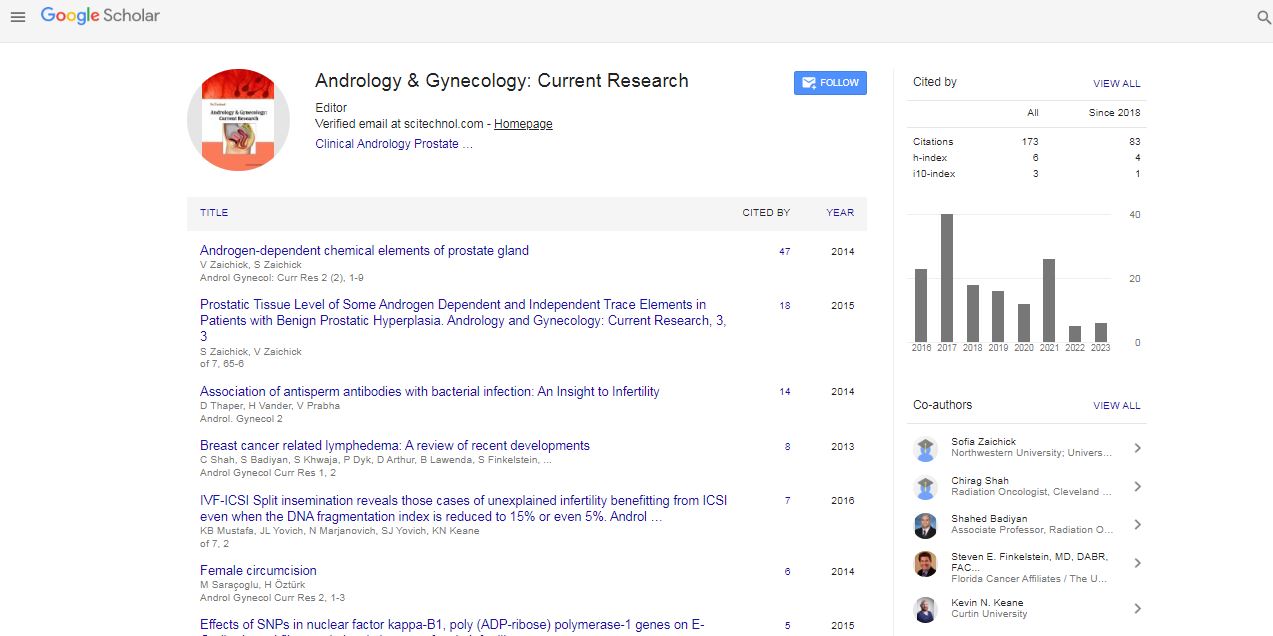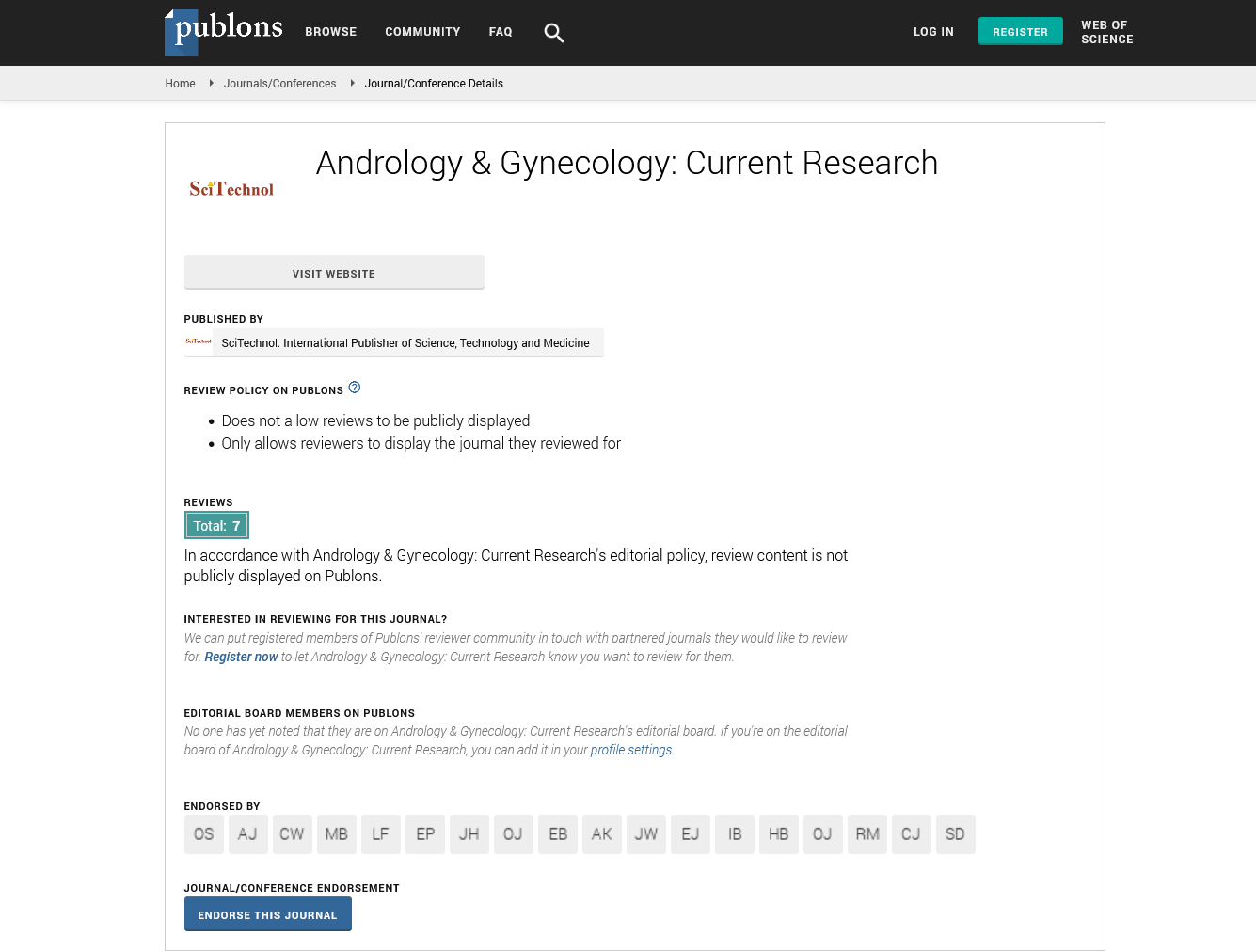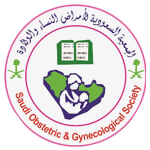Stick with you: A case of a type I CS scar pregnancy with concomitant placenta previa and placental accrete syndrome
Christine Veronica F Escarpe
Dr. Pablo O Torre Memorial Hospital, Philippines
: Androl Gynecol: Curr Res
Abstract
Cesarean Scar Pregnancy (CSP) has become a challenge for modern obstetrics. With an increasing frequency of pregnancies concluded with a cesarean section and the improvement of Transvaginal Sonography (TVS), there is also an increase in the number of diagnosed cases of CSP. The exact etiology to the development of CSP has not been fully understood but is presumed to be due to blastocyst implantation and invasion into the myometrium through a dehiscent tract or niche, which could be a result of previous trauma, particularly previous cesarean section. CSP can be a potential threat to the pregnant patient’s life leading to several complications including abnormal placental implantation, uterine rupture, hemorrhage and even death if timely management was not done. The aim of this case is to share our institution’s experience with CSP, review previous studies, emphasize sonographic criteria to make an accurate diagnosis. A multidisciplinary approach with an experienced team helps in reducing patient morbidity. A case of a 44 years old G6P3 (3023) from Bacolod City admitted due to vaginal bleeding. She is a known hypertensive and asthmatic. Family history included Hypertension, Diabetes Mellitus, and Bronchial Asthma. She had a total of six pregnancies with 3 live births, 1 abortion and 1 ectopic pregnancy. Of the 3 term pregnancies, 2 were delivered via NSVD and 1 delivered via Inverted T-Incision for Fetal Malpresentation. She was at 23 1/7 weeks age of gestation by early ultrasound on admission. On initial TVS, a thickened endometrium (1.8 cm) was seen to consider decidualized endometrium. Repeat scan ay 6 4/7 weeks done revealed a single, live pregnancy with a cardiac activity of 148 bpm. Another scan at 8 4/7 weeks showed a low lying gestational sac near the cesarean section scar site in the lower anterior uterine segment. The growth of the fetus was towards the endometrial cavity. Repeat ultrasound at 16 5/7 weeks age of gestation revealed a single, live fetus within the expanded mid portion of the lower uterine segment . The placenta was anterior, totally covering the internal os. Color mapping showed vascularity. The anterior myometrial wall was 0.15 cm thin. Uterine serosal and bladder interface is intact. A high suspicion of CSP was raised. Patient was informed that the pregnancy could develop into a placenta previa or accrete syndrome and that she may be at risk of having major hemorrhage that would require hysterectomy if pregnancy will be allowed to progress. After a thorough discussion with the patient and her family, she decided to continue with the pregnancy due to the desire of having a male offspring. Placental examination at 18 weeks showed loss of retroplacental sonoluscent space with the anterior uterine wall of the uterus markedly thinned out without normal looking myometrium between the serosa and bladder wall. Color mapping showed hypervascularity. CSP with placenta accrete was considered. She was managed expectantly and was advised on strict regular follow up. At 21 3/7 weeks, there was still expansion of the midportion of the lower uterine segment with a single, live fetus. The serosa was intact. The cervical length was 1.2 cm with funneling. Findings were suggestive of preterm labor. Advised admission but opted to be managed on an outpatient basis. At 23 weeks age of gestation, patient complained of vaginal bleeding. Repeat scan still showed short cervix at 1.1 cm with funneling. Oligohydramnios noted with AFI 3.5 cm. Patient was admitted and subsequently underwent Cesarean Hysterectomy with Bilateral Salpingectomy, Bladder Cystorrhaphy under General Anesthesia for beginning intraamnionic infection manifested by increasing C reactive protein levels. The surgery went well with an estimated blood loss of 4000 cc. Intraoperative transfusion of 2 units of PRBC, 1 unit of Whole blood and 3 units pf FFP. Patient tolerated the procedure. Patient was discharged in a stable state. Surgical pathological report revealed Sections thru the endometrium shows small chorionic villi. These are also noted to infiltrate the myometrium. The umbilical cord shows arteries and one vein. The cervix and both fallopian tubes are unremarkable. Cesarean Scar Ectopic Pregnancy (CSP) is one of the rarest forms of ectopic pregnancy occurring in 1 in 1800 to 1 in 2500. However, it constitutes 6.1% of ectopic pregnancies in women with a previous cesarean scar. Exact etiology is unknown but a damage to the endometrium and myometrium leading to implantation and invasion of blastocysts into the myometrium has been postulated. Is left, untreated it may progress to abnormally invasive placenta which can result to Placental Accrete Syndromes. The index patient had 1 completion curettage and 1 cesarean delivery (Inverted T-incision) done six years prior. Any woman with a prior cesarean delivery should be aware of the possibility of CSP. The discovery of CSP in the index patient was an incidental finding on her first trimester scan. A correct diagnosis is important as it enables physicians to establish appropriate management for the patient. The patient was able to fulfill all the sonographic criteria for the diagnosis if CSP. A type I CSP was considered since the growth of the fetus was into the endometrium, thus an ultrasound image can appear as an intrauterine pregnancy. A high index of suspicion is needed to differentiate Type I CSP from a normal pregnancy. Ultrasound imaging has remained a principal modality of choice in diagnosing CSP. Although literature showed that a live CSP requires immediate and decisive action to prevent further growth of the fetus, the index patient opted to do expectant management initially because of the desire of having a male offspring. However, patient went into preterm labor with a beginning intraamnionic infection, thus delivery was carried out. There is no universal management for CSP. Treatment options are individualized and based on the patient’s age, number of living children, need for future child bearing, hemodynamic condition and viability of the pregnancy. The expertise of the clinicians and the availability of facilities to manage such cases is also a consideration. The dilemma lies on whether to terminate a live pregnancy or to continue the pregnancy with a possibility of delivering a live offspring, provided that she understands the risk and possible complications, often necessitating hysterectomy. The increasing number pregnancies concluding to cesarean deliveries has been associated with an increased incidence of Cesarean Scar Pregnancies. A high index of suspicion coupled by an accurate sonographic diagnosis must be done to provide optimal management to the patient and thereby reducing overall maternal morbidity and mortality. Keywords: Cesarean Scar pregnancy, transvaginal sonography, Placenta Accreta.
Biography
Christine Veronica Escarpe completed her Primary Education in Mary Infant Jesus School, lligan City, Class Valedictorian Graduated March 2001 and her Secondary Education, Graduated March 2005 Philippine Science High School, Tubod, Lanao Del Norte. She did her Bachelor of Science in Nursing, Mindanao Sanitarium and Hospital College, Iligan City Graduated March 2010. Doctor of Medicine, Graduated April 2015, Cebu Institute of Medicine, Cebu City. Postgraduate Internship, 2015-2016, Dr. Pablo O. Torre Memorial Hospital (DPOTMH), Bacolod City. Ongoing Residency Training, Department of Obstetrics and Gynecology, Dr. Pablo O. Torre Memorial Hospital (DPOTMH), Bacolod City.
 Spanish
Spanish  Chinese
Chinese  Russian
Russian  German
German  French
French  Japanese
Japanese  Portuguese
Portuguese  Hindi
Hindi 


